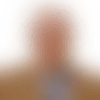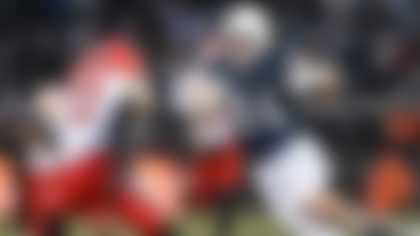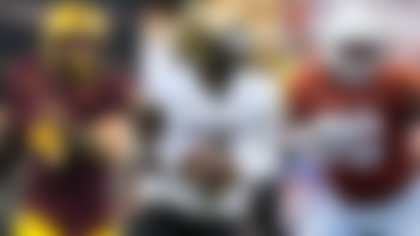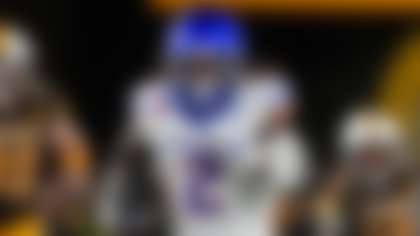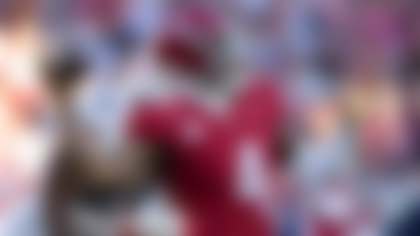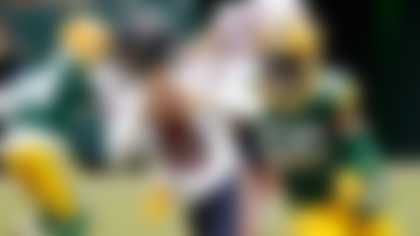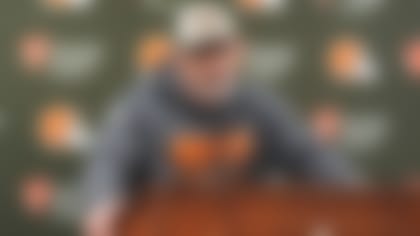Before we know it, another crop of fresh talent will be hitting the NFL. With all the mock drafting and prognosticating that has gone on over the past couple of months, you would be forgiven for feeling a bit lost in the woods when it comes to this year's class. So with the 2018 NFL Draft just days away (Round 1 kicks off on April 26), I've put together my list of the top 150 prospects poised to potentially impact teams across the league this fall.
Penn State's all-time leader in yards from scrimmage (5,038) has traits that in the past have led to All-Pro-caliber production at the NFL level. He set the school record for rushing touchdowns (43) in just three seasons. He's the fourth Big Ten player to notch 3,000 rushing yards and 1,000 receiving yards in his career. And he's a great character person.
I don't have any questions about this young man with regard to the chatter about his character. A good athlete, Rosen has a strong arm and accuracy -- he can make all the throws. By Year 2, he'll be a successful starter in the NFL. I really like this player.
Darnold combines a quick release with very good accuracy and mobility. His 2017 numbers were a step down from 2016, but he was not working with a great receiver corps last season. Darnold has the ability to be a franchise quarterback and a factor in this league for years to come.
Mayfield is a Drew Brees-lookalike in terms of height, speed and accuracy. He had a few bad moments off the field, but he's not a bad person. He's a sharp player with the arm strength needed for success -- Mayfield will compete, work hard and be a long-term starting QB in the NFL.
Chubb really helped his stock by staying in school for his fourth year. He's a very good pass rusher with excellent initial quickness -- he's got burst as a rusher. Chubb (25 career sacks) is a future Pro Bowler who will start immediately in the NFL.
Edmunds' father, Ferrell Edmunds, was a seven-year NFL player who reached the Pro Bowl twice, and one brother (Trey) plays for the Saints while another (Terrell) played with Tremaine at Virginia Tech. He has an 83-inch wingspan, and with his size and speed, he'll be hard to block coming off the edge. He also has the athletic ability to play in space. Edmunds is young (turning 20 in May), but he'll start in Year 1 and be a Pro Bowler by Year 2.
The very smart and very athletic Allen needs to improve his accuracy, but I think he can do that with some work. He has great talent for the position and can throw the ball 70 yards with ease. Allen has the traits to become an All-Pro; as to whether he can fulfill that potential, only time will tell.
Nelson plays like All-Pro Cowboys guard Zack Martin. He's very strong (35 lifts at the NFL Scouting Combine) and has 33 3/4-inch arms. A good player, he'll start and contribute from the get-go.
Ward will be the fourth Ohio State corner to be selected in the first round of the draft in the last three years. He had an outstanding 2017, with 17 passes defensed (15 break-ups and two picks) and a blocked punt. I wish he were a little taller than his listed height (5-foot-10), but he has good coverage ability, is strong against the run and will contribute on special teams.
At Alabama's pro day, Fitzpatrick ran a 4.13-second short shuttle and a 6.73 cone drill -- those two drills are a very important indicator of future success. He can play corner, nickel or safety. Fitzpatrick has great character, smarts and athletic ability, and he'll be a rookie starter with Pro Bowls in his future.
Vea pulled a hamstring after running his second 40-yard dash at the NFL Scouting Combine and was not able to work out at his pro day. He's very strong (41 lifts at the combine) and moves well for a player his size. Vea started 13 games in 2017 and was named All-Pac-12.
Davenport will get better every year and has a chance to become a good pass rusher in the NFL. He's very athletic and has good character and excellent work habits.
The very competitive Smith has short-area burst and explosion, plus football intelligence, to boot. He posted 11 tackles (including four solo and one for loss) while earning Rose Bowl defensive player of the game honors. He'll start right away.
James missed most of the 2016 season with a lateral meniscus tear but came back in '17 to start all 12 games. Fast and very athletic, he'll compete as a first-year starter in the NFL. James played a dominant role in Florida State's defense.
The team and city that ends up with Hernandez will love him -- he's a top character person who will play at a high level for a long time in this league. He's very strong (37 lifts at the combine) and excels in both run-blocking and pass protection.
Alexander only started six games in 2017 due to injury, but his numbers in the short shuttle (3.98 seconds) and three-cone (6.71) tell you he'll be a starter and play well. If you want to see his skills on display, take a look at his tape from the Florida State and Clemson games in 2016.
Vander Esch posted 141 tackles and three picks in 2017, including a 16-tackle, two-sack outing against Washington State. He's an outstanding athlete who will be an NFL fixture. A product of eight-man football in high school, Vander Esch can play all three downs on defense.
Though Alabama was more of a running team than a passing team during Ridley's tenure, the receiver still posted eight games of 100-plus receiving yards in his career. Ridley is a good route-runner who catches the ball in his hands rather than trapping it against his chest.
Moore improved a lot over his three years in school. He'll catch in a crowd and has above-average hands, two combine drops notwithstanding. He also ran better than I thought he would (4.42 40). I'm not sure he's No. 1 receiver material, but Moore has tons of upside.
Payne shows good athletic ability -- he even served as the lead blocker a few times on the goal-line offense and caught a touchdown pass. He was also defensive MVP of the Sugar Bowl. Payne is better defending the run than he is rushing the passer.
The youngest player to win a Heisman Trophy (in 2016), Jackson has good arm strength, though he's more of a runner than a passer -- like Jerry Rice, no one has ever caught him from behind. His career completion rate is just 57 percent, but he improved from one year to the next, bumping that figure from 54.7 in 2015 to 59.1 in '17. It would be best for him to go to a team that does not need him to play immediately, like, say, the
Steelers.
</content:power-ranking>
Williams missed seven games in 2017 due to a knee injury suffered against USC, but he had an excellent 2016. He came back for the final two games last season and played well. He's very athletic but might make for a better guard than tackle.
The very competitive Daniels would rank higher if I had a confirmed 40 time for him. He's athletic and can get to the second level.
Michel rushed for 3,613 yards at Georgia, more than Todd Gurley or Garrison Hearst. He'll pass protect and catches well. The big question is, why did he only start 11 games in four years? I like the player and think he'll succeed in the NFL.
The converted receiver led the nation with eight picks and 26 passes defensed in 2017. He should start as a rookie and settle in as a long-term contributor.
A strong (30 lifts), competitive player, Bryan should be a factor as a starter from Day 1.
Evans looked fast getting to the ball -- I wish we had confirmed times for him. He's a good tackler who gets off his blocks with ease. He's also a good blitzer. 2017 was his first season as a full-time starter, but he'll make plays and compete.
Miller had a great pro-day workout, but he needs some additional seasoning. He reminds me of Nate Solder when he came out of Colorado and was drafted in Round 1 by New England. Miller will need to go to a team with a very good offensive line coach to help him get his career off on the right foot.
Guice will make a difference for someone out of the gate for a team in need of a back (like, say, the Giants). He has good hands and the quickness needed to succeed at the position.
Hughes is the only player in school history to return a punt, kickoff and interception for a touchdown in the same year. He does not have ideal size for the position, but he does have good quickness and instincts. He started at North Carolina but left after a year, had some off-field problems, then spent a year in junior college before landing at Central Florida.
Goedert posted two consecutive 1,000-yard seasons and is a two-time FCS All-American. A very good athlete, he has lots of upside and posted great pro-day numbers in the vertical jump (35 inches) and cone drill (7.08). His father named him "Dallas" because he's a Cowboys fan.
Sutton's route-running ability is limited, but he can show separation after the catch. He has very good hands and makes difficult catches. Sutton looked excellent at his pro day and possesses lots of upside. He's also a great character person.
Chubb has great character and would fit well on a winning team. He's strong (29 lifts) and rebounded well in 2017 after missing much of '15 with a knee injury. In Georgia history, only Herschel Walker has more than Chubb's 4,769 career yards.
Wynn had surgery in January on his left labrum and was unable to work out at the NFL Scouting Combine or Georgia's pro day, though he did play in the Senior Bowl. He's very strong and athletic and will compete at a high level for a long time. His best NFL position will be guard, but he could fill in at tackle.
Landry played in just eight games in 2017 because of an ankle injury, but in '16, he set a school record with 16.5 sacks. Since 2014, only three college players have posted three career three-sack games: Landry and past first-round picks Derek Barnett and Myles Garrett. The athletic Landry has outstanding pass-rush ability when healthy -- he has the speed and quickness to excel in that role in the NFL.
A very explosive athlete, Kirk should be a standout slot receiver. He's also a good kick returner. I love this player. It's hard to understand why he only put up 12.6 yards per catch, though Texas A&M's lack of a passer might have had something to do with that. I question if Kirk will ever be a No. 1 receiver, but he'll work hard and contribute.
Hurst -- who played baseball in the Pittsburgh Pirates' organization before walking on at South Carolina in 2015 -- was a two-year starter for the Gamecocks who set a single-season record for catches by a tight end with 48 in 2016. He's also a willing blocker.
Jackson played corner, nickel and free safety for LSU, and he can also return punts. For his size, he's a good tackler and plays with toughness. I don't normally like corners under 190 pounds, but Jackson might be the exception to that rule.
An ankle injury cost him the last five games of the season and required surgery. He's a tough, hard-working player who played both guard and center at Arkansas. I wish he was faster in the cone drill (8.04). Still, he'll be a starter by Year 2.
The athletic and very smart Gesicki will need time to develop, but he's got all the traits needed to be successful once that happens. He must learn to block better, but he can do that -- bring in former NFL tight end Mike Ditka to show him.
Crosby missed most of 2016 with an injury but was named Pac-12 Offensive Lineman of the Year in 2017, when he did not allow a sack. He has very long arms (35 1/4 inches) and big hands (10 3/4 inches), but he needs to get stronger. He has the toughness and mental acuity to be very good in the NFL.
He'll most likely be best as a press corner because of his size (6-foot-1, 203 pounds), long arms and strength. Davis played well in 2017 and had 33 passes defensed in his three-year career. He ran faster at his pro day than he did at the combine, but I would have liked to have seen better marks in the short shuttle (4.31) and cone drills (7.30).
Oliver came to Colorado as a receiver but converted to defense and flourished, posting 32 career passes defensed and three picks. He has long arms (33 1/2 inches) and an 80-inch-plus wingspan. Oliver can also return punts.
Jones is a hard player to grade. His production at both the high school and college level is there, but he didn't look great working out at USC's pro day. He should be a starter, but that's not a lock.
Chark is a size-speed player with lots of upside as a receiver. He played very little in his first two years at LSU but averaged 21.9 yards per catch in 2017 with three touchdowns on a run-centric team. He's got a high ceiling but a low floor. My question is, how good are his hands?
Brown ran better and lifted more at his pro day than he did at the combine. I think he can play right tackle and contribute in the run game. He's got very long arms (35 inches) and was very well-coached at Oklahoma. He's an enormous man with a wide base and an 85-inch wingspan. He's got a good attitude and is smart. He just needs to keep his weight at a manageable number and work on getting stronger. His dad, of course, was former NFL player Orlando Brown Sr.
The well-coached Harrison will tackle with power, though difficulty changing directions will hurt him at the next level. He never ran the short shuttle or cone drill but did post a 4.63 40 at his pro day, and he finished with seven career interceptions.
Reid enjoyed an excellent 2017, posting 99 tackles and five interceptions (including picks of Sam Darnold and Josh Rosen). He seemed to improve each year at Stanford and should be able to cover well, thanks to his speed. His brother is former first-round pick Eric Reid.
Shepherd played two years of college ball in Canada (2011 and '12) and was out of football for two more (2013 and '14) before walking on at Fort Hays State and starting three years. Though he'll be a 25-year-old NFL rookie, he has the traits to succeed at that level, and I expect him to perform as well against pro competition as he did against his Division II opponents. He did not lift at the combine, but the Falcons sent their entire staff to work him out.
Follow Gil Brandt on Twitter _@GilBrandt_.
